
Arquivo para a ‘Pintura’ Categoria
The intermittents of death
José Saramago (1922-2010), in addition to his famous book Essay on Blindness, written in 1995 and which later became a film directed by Brazilian Fernando Meirelles and scripted by Don McKellar, wrote many other novels: O memorial do convento (adapted from an opera), The Gospel According to Jesus Christ, Essay on lucidity, and many others, I highlight here As Intermitências da Morte (2005).
Essay on Blindness, written in 1995 and which later became a film directed by Brazilian Fernando Meirelles and scripted by Don McKellar, wrote many other novels: O memorial do convento (adapted from an opera), The Gospel According to Jesus Christ, Essay on lucidity, and many others, I highlight here As Intermitências da Morte (2005).
In 1998, he received the Nobel Prize for Literature, but two works seem prophetic for today: The essay on blindness, which we have already posted, and the Intermitências da Morte.
Skeptical and ironic, Saramago did not fail to notice the dramas of our time, but the unexpected way it ends. Lucidity, I would say using the Heideggerian metaphor that clearing is possible if we penetrate the existential drama of life.
In The Intermittencies of Death, he penetrates into the existential dramas of life, as a religious skeptic, he will also mock the outputs with an answer “from above”, that is, transfer to “another world” our permanently mundane dramas, among them, what it’s life itself.
He says in a passage on page 123: “It is possible that only a painstaking education, one of those that is already becoming rare, along, perhaps, with the more or less superstitious respect that in timid souls the written word usually instills, has led readers, although they were not lacking in reasons to manifest explicit signs of ill contained impatience, not to interrupt what we have been reporting so profusely and to want to be told what it is that, in the meantime, death has been doing since the fatal night when it announced the your return.” (in the photo a picture of Gustav Klimt’s painting).
After inquiring in every book about life, something unusual these days, because all you want is a return to frivolity, the normality of emptiness, the absence of life, consumption and false joys, the author will say in end of the book that death is normality, said like this:
“He stayed in his room all day, had lunch and dinner at the hotel. Watched television until late. Then he got into bed and turned off the light. Didn’t sleep. Death never sleeps.” (Saramago, 2005, p. 189).
And he concludes that his common irony in times when the pandemic was not even dreamed of (his pandemic was The Essay on Blindness), he says about death: “(…) I don’t understand anything, talking to you is the same as having fallen into a labyrinth without doors, Now that’s an excellent definition of life, You’re not life, I’m much less complicated than it, (…)” (Saramago, 2005, p. 198). Oh what a pity, a pity even that Saramago had never believed in a true life, this disbelief is also in all his work, especially “The Gospel According to Jesus Christ” (1991), but at least he was not indifferent to the theme, something “bothered him”.
SARAMAGO, José. (2005) The intermittence of death. Brazil, São Paulo: Companhia das Letras.
Bliss and beatitude
Although the term is associated with Christian holiness, and is also one of its aspects, the term in classical antiquity had a more generic meaning, a permanent state of perfect satisfaction and fullness that only a wise man could achieve, so thought Aristotle, but today it is conditioned only to the religious sense, it is intended here to show that they can be closer than we think.
The religious meaning is also that of happiness, but in the sense of joy of balanced pleasure of the soul, which can only reach those who enjoy the presence of God, that its fullness can be achieved only in eternal life, but does not mean discarding earthly life, 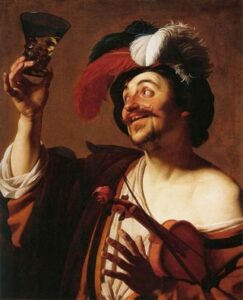 “I have come that everyone may have life, and life in abundance” (John 10:10), so proclaims the evangelist, but what is different between the two proposals for happiness.
“I have come that everyone may have life, and life in abundance” (John 10:10), so proclaims the evangelist, but what is different between the two proposals for happiness.
Aristotle in the book “Of the causes” will say that the end of beatitude is relative to its desire, so the ultimate nature of this end moves mainly by desire and this is pleasure, so much so that it absorbs man’s will and reason to the point of make other goods despise.
Both Boethius, that the church also beatified him (that is, he proclaimed him happy, blessed and holy), and Aristotle dealt with the theme, and their question is what if pleasure is really the ultimate end of happiness, of beatitude and that it also Tomás de Aquino will argue the contrary.
What Boethius says is that the consequences of pleasures are sad, all those who want to remember their sensualities know it, because, if these could make them happy, there would be no reason why the brutes too would not be considered such, and this is very reminiscent of current cases of abuse and objectionable violence.
For Boethius: “The beatitude is the perfect state of the union of all goods”, and so it seems that through money you can acquire all things, because the Philosopher, in book V of Ethics, says that money was invented for to be the guarantor of everything that man wanted to possess, which today can be translated as money buys everything.
In addition, Boethius also says: “Riches shine more when they are distributed than when they are conserved. For this reason, greed makes men hateful, generosity makes them illustrious ”, and so wealth is not condemned, but its bad distribution.
In the representation above the painting “The cheerful violinist with a glass of wine” (1624) by Gerard van Honthorst (1590-1656).
Between tragedy and idealism
The big theme during the pandemic, which attracts crowds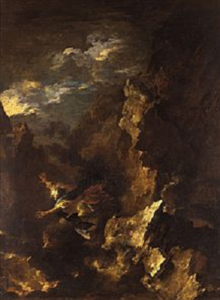 is happiness, not by chance, since happiness was in everything that is now closed: the mall, the cinema, the houses of orgies and drinking, the simple ecstasy of being in a frenzied crowd for some frivolous reason, after all it is the frivolity that everyone wants to come back, there will be nothing great to penetrate the tragedy of a pandemic, it is necessary to find the culprits and punish them for banishing frivolous life and putting us all in constant tension, in fear and far from simple enjoyment.
is happiness, not by chance, since happiness was in everything that is now closed: the mall, the cinema, the houses of orgies and drinking, the simple ecstasy of being in a frenzied crowd for some frivolous reason, after all it is the frivolity that everyone wants to come back, there will be nothing great to penetrate the tragedy of a pandemic, it is necessary to find the culprits and punish them for banishing frivolous life and putting us all in constant tension, in fear and far from simple enjoyment.
Nietzsche wrote about The Birth of Tragedy, and blamed Empedocles for his death, but it was Hölderling who will write about Empedocles’ Death, it was he before Nietzsche who rediscussed the tragedy, and the tragic of the tragedy, in a dialogue with German idealism and that’s when he coined his most famous phrase: “where there is fear there is salvation”, almost in the same vein as Cassius Clay who became Mohammed Ali: “it is the lack of faith that makes people fear challenges”.
The pandemic is none other than the fact of understanding the limits of the human, the persistence of tragedy in our lives and destinies, and the fatality of death, those who never thought of it are those who fear it most now, it is never so close of all, but tragedy is evil, or the false sale of easy happiness, it is in it that the charlatans of philosophy, faith and even science without “label” rely.
The Death of Empedocles, an unfinished play, where Hölderlin worked from 1797 to 1799, in his poetic texts from this period, where he thought about the essence of the tragic is marked by a great antagonism, but above all the unification of antagonism with contradiction, where he makes it clear that the theme should be “the true modern tragedy”, perhaps not during the two tragic wars we face, but now in an endless pandemic.
In his analysis, Empedocles hates civilization, is a mortal enemy of limited human existence, cannot bear to live under time, suffers for not being a god, for not being in close union with the whole, and for a need that stems from his being deeper, I decide to die by throwing myself into the volcano.
He is less of a liar than the real ones of simple formulas for happiness, but tragic that he wants to be a god himself and that he would be more “noble” than to admit a God, killed not by tragedy, but by German idealism, after all from Fichte to Schelling, the great expression that transgresses the limit imposed by Kant on human knowledge, when considering all intuition, that which is sensitive to objects, becomes intellectual intuition and artistic intuition, being able to give an immediate knowledge to the absolute, of possibility revelations that are directed to the whole.
So in the essay “Foundation for Empedocles” says that tragedy is the expression of the “deepest intimate unity” that is exposed by real oppositions, the idea owes not only much to Schelling’s analysis, which defines the Greek tragedy as a reconciling presentation of contradictions of reason, but anticipates the Hegelian view of the tragic poem as a presentation of the “tragedy that the absolute eternally stages with itself”, but the absolute here is vague, ideal. In the “foundation for Empedocles”, Hölderling explains how the harmonious opposition between art and nature takes place, presenting the process by which nature becomes more organic and man, more agorgic, more universal.
The concept of aorgic here is fundamental, and the reading here is by Françoise Dastur “Hölderling, tragedy and modernity” where he defines it as “it is nature without organicity in its infinite uniqueness”.
The organic is the art, which supposes, on the contrary, organization and, therefore, opposition from the parties”.
In the aorgic relationship that can be found the pandemic, the culprit is ultimately the virus, the control of the virus is questionable until you have the vaccine, we were in favor of social isolation and at certain times of #LockDown, however it is in nature devoid of organicity, a virus that until then was foreign to the man who altered it and became hominating, putting the civilizing process in check, and nature seems to fight back what humanity proposed.
Hölderling, Friedrich. (2008) The dead of Empedocles A Mourning-Play. NY: State University of New York.
A pandemic with many outbreaks
Although the large centers, São Paulo and Rio de Janeiro States in particular, registered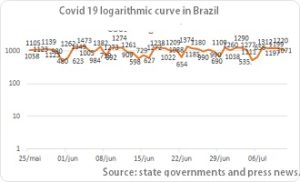 declines in the number of infected and deaths, the pandemic has internalized and now reaches the innermost part of the country, which includes small poor cities, indigenous villages and regions with little access. Restroom.
declines in the number of infected and deaths, the pandemic has internalized and now reaches the innermost part of the country, which includes small poor cities, indigenous villages and regions with little access. Restroom.
The general graph (of deads) shows a stabilization around 1200 daily deaths, but it does not mean the control of the disease, nor any indication of a fall, since the expansion into the interior and deprived areas can cause new explosions, allied to an innacute opens of trades without criteria.
We present the general graph above just to indicate a general graph, since the policy under the responsibility of the regional governments and mayors (it was determined by the STF) does not allow us to say that there is a national policy of combat, although the regional health secretariats communicate and governments make state laws, such as the one that obliges the use of masks, with some regional control.
Another controversial issue is the use of medications, hydroxycloquine, the initial controversy, and now azithromycin, ivermectin and nitazoxanide are not recommended by medical criteria, the drugs in the background are given on a case-by-case basis, for example, for infectious conditions, depressive symptoms or respiratory problems that are acute, but each patient may or may not have conditions that prevent the use of a certain medication.
At the international level, some measures on economic weakness are beginning to be considered, such as helping the unemployed, how to articulate joint action plans between countries, the great example of which is the euro zone.
Preventive measures must continue for a long time, which I prefer to call social distance, because flexibility is already growing and little controllable, wearing masks, maintaining a certain distance in transport, walking even considering that they are done in airy areas are necessary and are part of of the so-called new normality, it is enough to see the countries left the peak.
At the social level, measures to prevent the worsening of the social crisis should be considered in the world.
The cultural crisis and the pandemic
The second great blindness of the Western crisis is culture, the book Anything Goes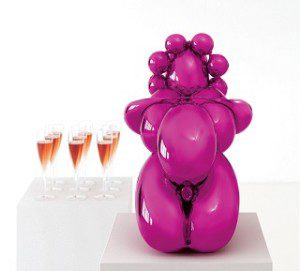 by Theodore Dalrymple, pseudonym of english´s psychiatrist Anthony Daniel who treated dangerous prisoners, is an anthology of short stories written from 2006 to 2009, and called his studies declinology (see the video below) but in the book cited there are beautiful passages on how to read a culture. in many countries.
by Theodore Dalrymple, pseudonym of english´s psychiatrist Anthony Daniel who treated dangerous prisoners, is an anthology of short stories written from 2006 to 2009, and called his studies declinology (see the video below) but in the book cited there are beautiful passages on how to read a culture. in many countries.
Since the dawn of human culture, the discovery of the Chauvet Cave (dated 32,000 BC) proves this, man builds and records his culture, and here a parallel with #StayAtHome this is done in a cave, probably a meeting place and protection of families.
It may seem too much the term used by Peter Sloterdijk, but human domestication is nothing other than the structuring of “domestic” life, and also the Greek origin of the word oikos-nomicus (we have already made a post) means oikos – home.
We add here Xenophon’s Socratic dialogue, which refers to the term how to be a good gentleman, Kalokagathos (good in beautiful, in Greek), which is thus a reference to culture.
Byung Chul Han, who wrote Salvação do Belo, where he criticizes the culture of the plain and in particular that of Jeff Koon and his sculptures of “baloons” (figure) that say a lot or nothing, the desire for total immunity, without seeking the co-immunity, concept of its master Sloterdijk, that can be applied to the current pandemic.
A hard article, even for me as an appreciator of Chul Han, about the current pandemic crisis, published in El País, states that: “it seems that Asia controls the epidemic better than Europe”, quotes the data of March 20 when the epidemic had not yet reached its peak in Europe and is based on the disciplined and ancestral structure of the east.
Earlier than us, they bet on Big Data, says the author, and “they suspect that big data may have enormous potential to defend themselves against the pandemic” says in the article by El País, but warns that this could lead to a digital dictatorship, as in China and this is not a change.
About the current culture, the author affirms “today not only the polished is turned to the beautiful, but also the ugly” in the work A Salvação do Belo (page 19), we hope that the scourge of the virus will move our hearts and make us go from discovery from interdependence, as Morin says, to solidarity.
https://veja.abril.com.br/videos/clube-do-livro/uma-aula-de-decliniologia-com-theodore-dalrymple/
The sense of pain and sacrifice
Death causes us pain, fear and even despair; in the face of a pandemic, it reveals aspects of tragedy, anxiety and apprehension, and we can do everything we can to prevent greater pain, but some go further and worry and donate to reduce the pain of others.
aspects of tragedy, anxiety and apprehension, and we can do everything we can to prevent greater pain, but some go further and worry and donate to reduce the pain of others.
This is a human meaning, but the divine goes beyond what it means to be able to donate one’s life, or to put it at risk for the sake of the Other, only in this limit do we really understand the meaning.
Teilhard de Chardin, after admitting that the cross means “evasion out of this world” (p. 114), will explain to us that it is precisely it (in the present case the fear of death by the pandemic, “that exactly the path of human effort , supernaturally rectified and prolonged.
Because we have fully understood the meaning of the Cross, we no longer risk thinking that life is sad and ugly. We simply become more aware of its unspeakable seriousness.”(page 115).
So we thought of the happy days that we could walk freely and savor the air of the city, see the beaches now banned from being visited, the joyful family lunches, but it is for this loss that we now look with other eyes whose blindness could not allow.
How beautiful it would be an Easter Sunday with the whole family, or just going out to see happy autumn days in the southern hemisphere or early spring in the northern hemisphere, but it is this pain and this terrible pandemic that makes us “change glasses”, also in spiritual aspect.
So Chardin points out: “the cross is not an inhuman thing, but a superhuman one. We see well that the origin of Humanity today, the Cross was erected at the front of the road that leads to the highest peaks of creation ”, we will have to rethink home and social life after this pandemic. Chardin invites us to the mystery: “let us get closer. And we will recognize the flamed Seraph of the Alverne (picture), the one whose passion and compassion are “incendium mentis” *. For the Christian, it is not a question of disappearing in the shadow of the Cross, but of ascending in the light of the Cross.” (page 116).
Take advantage of this night of the pandemic to shed light on the “night of culture”, on the “night of God” and on the “night of the senses” that seemed to make us suppress all sensitivity to human life and the Other.
Let us live these three “nights” well to achieve an Easter (in sense of passage) for all humanity.
* incendium mentis – David Grummet says that in Chardin it is “fire of divine love in our soul”.
Chardin, T. (no year) O meio divino (The divine medium). Lisbon: Editorial Presença.
Tragedy and the arts
I am not speaking here of tragedy in the ordinary sense, but as an artistic category that is not only important for understanding the arts and beautiful Greek, but is claimed as a new idea of tragedy “as proposed by Hölderlin, Hegel or Nietzsche.” (Ranciére, 2009, p. 25).
sense, but as an artistic category that is not only important for understanding the arts and beautiful Greek, but is claimed as a new idea of tragedy “as proposed by Hölderlin, Hegel or Nietzsche.” (Ranciére, 2009, p. 25).
Just as Byung Chul Han in “The Salvation of the Beautiful” will problematize the dualism between contemplation and action, typical of modern philosophy that separates subject from object, Rancière penetrates further by proposing his “aesthetic revolution”, stating that what is there is “The abolition of an ordered set of relations between the visible and the sayable, knowledge and action, activity and passivity” (Ranciére, 2009, p. 25).
I said this when analyzing the Oedipus of the “psychoanalytic revolution” that invalidates “those of Corneille and Voltaire and who intends to resume – beyond the French tragedy, as well as the Aristotelian rationalization of tragic action – as the tragic thought of Sophocles” (idem , p. 25).
Ranciére will discuss in the following pages of his chapter on the “aesthetic revolution” on psychoanalysis saying that it is “invented at that point in which philosophy and medicine are mutually questioned to make thinking a question of disease and disease a question of thinking ” (Ranciére, 2009, p. 25), in paint above Marie Spartali Stillman (1844–1927),.
A large part of modern neo-therapies (I call exoteric psychoanalysis) go around, as if the problem of idealistic thinking was “disease” and a large part of human suffering could be solved as “thought” transforming it into disease.
This happens due to a bad relation with the thinking of tradition, late modernity is nothing but the bad reading of rationalism and idealism, or the delayed reading of empiricism, the thinking of Hanna Arendt’s “active” action, expressed in Byung Chul Han , is also part of the thinking of tradition that Ranciére will identify in the “representative regime as an absolute power of making” (Ranciére, 2009, p. 27).
It clearly identifies this regime in Baumgarten’s discourse on “confused clarity”: “in the aesthetic regime, this identity of knowledge and non-knowledge, of acting and suffering, which… constitutes the very way of being of art ”(Idem, p. 27), of course this is the art of tradition. And so it says, that the aesthetic revolution had already started with Vico, in his New Science, who against Aristotle and the representative tradition, although Rancière knows that his problem was not the theory of art, but the theological-poetic problem of “ wisdom of the Egyptians ” about hieroglyphs.
What place does aesthetics occupy in our time
I imagined that it would be difficult, even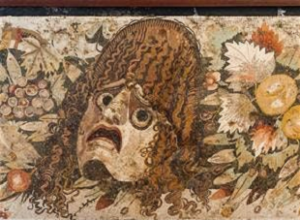 impossible, to approach the subject, since it is concerned with art critics of various types, Freudian psychoanalysts and very rarely anyone with our aesthetic, in the sense of beautiful Greek, or the contemplation of which Byung Chull speaks Han.
impossible, to approach the subject, since it is concerned with art critics of various types, Freudian psychoanalysts and very rarely anyone with our aesthetic, in the sense of beautiful Greek, or the contemplation of which Byung Chull speaks Han.
I found in a small text by Jacques Rancière, I am increasingly meeting this author, who came to know his work almost by chance (The emancipation of the spectator), referring to the theme as the aesthetic unconscious, but he himself explains it at the outset. psychological aspect of the theme.
I find right at the beginning of the book: “aesthetics does not deal with science or the discipline that deals with art.
Aesthetics designates a way of thinking that deals with the things of art ” (Rancière, 2009, p. 11) and this would be enough, but it complements their thinking and that they seek:“ to say what they consist of as things of thought. ” ( Rancière, 2009, p. 12).
It is a finding, but it could not be otherwise in a dialogue with the Kantian “tradition”, the following complement follows, saying that art as a thought is a recent reference and refers to the work Genealogy of art by Baumgarten of 1790 as the criticism of the Faculty of Judging of Kant.
From Baumgarten, a simple reference in his work would suffice, referring to the union of objects that “must be thought in a beautiful way with causes and effects, as this union must be sensitively known through the analogue of Reason” (Baumgarten, 1933 , p. 127) and so both he and Kant will establish “confused thinking” about the definition of aesthetics.
Rancière will say that both when calling Kant’s confused or heterogeneous sensitive thought, both will make art “no more than a minor knowledge, but a knowledge of what is not thought” (Rancière, 2009, p. 13) and the note of author will link it to enlightenment and liberalism.
There is no explicit reference to Nietzsche’s thought about art, but when discussing Oedipus, the most typical Greek tragedy and Nietzsche defends its role in art, he says about the Freudian use of this tragedy as “universal”, which at the same time encompasses three aspects: “a general tendency of the human psyche, a determined fictional material and a dramatic scheme considered exemplary.” (Rancière, 2009, p. 15).
Of course, this is only introductory, what Ranciére wants to explain is that it is not a matter of subjective or “confused knowledge”, but “a paradoxical union of disease and medicine that is, a paradoxical union of the two” (p. 26) in a reference to “The birth of tragedy” of the Nietzsche, what idealism as thought and romanticism as “aesthetics” want to deny.
Rancière, J. (2009) O inconsciente estético. trad. Monica Costa Netto. São Paulo: ed. 34.
The complexity, the infinite and God
Except for areas such as art and sectors of astrophysics, the rest of scientific research is a prisoner of its own methodologies, designed to “maintain the balance of discourse by banishing contradiction and wandering; controlled or guided all developments of thought, but it itself stood out as impossible to solve. ”(Morin, 2008, pp. 80-81).
astrophysics, the rest of scientific research is a prisoner of its own methodologies, designed to “maintain the balance of discourse by banishing contradiction and wandering; controlled or guided all developments of thought, but it itself stood out as impossible to solve. ”(Morin, 2008, pp. 80-81).
It does not mean, of course, to destroy the balance and rationality of human thought, but to let it penetrate: in a sense of the simplest, the most elementary, the most ‘childish’: changing the basis of reasoning, the associative relations, and repulsive among some early concepts, but upon which the whole structure of reasoning and all possible discursive developments depend. And that is, by the way, the most difficult. ” (Morin, 2008, p. 82).
So we start from the “childish” idea of infinity, but which is the great scientific complexity of modern thinking as well, the immensity of the universe that is 96% mass and dark energy is still mysterious, but it may help us and finally the idea that in this infinity there is more than one energy, there is a living Being that precedes the universe itself can be another generous “childish idea”: God.
The eschatology that derives from these two fundamentals, a mysterious universe and a Being that precedes everything (in Christian eschatology is a Trinitarian God, who is also the ‘divine man’ Jesus), can give us a new dialogue in which what we think about matter. , spirit and science can change.
The essential relationship of God through Jesus with the world has as its crucial point the substitution of the metaphor of the lamb that Abraham killed in place of his son (the origin of God’s lamb comes from there), and is manifested by the evangelist John about John the Baptist ( Jn 1:29) who saw Jesus approach and said, “Behold the Lamb of God, who taketh away the sin of the world.”
The Josefa d’Obidos painting that we have already posted here by virtue of building a hologram installation is depicted above.
The Essentials List
We carry too many burdens, not just our bags, bags, even books and too much to do, because the contemporary world has difficulty making the list of the essentials.
to do, because the contemporary world has difficulty making the list of the essentials.
Taking care of small household chores, not just leaving them to others, taking work seriously and taking time to rest, also dealing with what can get us out of the stress and anxiety of everyday life, having time for family members and to meditate , contemplate or even just think.
Baroque paintings, paintings and music seem to speak of a still world, too calm for my taste, some would say, but the aspects of flowers, bodegons, and still life indicate something else that is hard to see these days: flow power.
It is not the energy of force, but the energy of soul and spirit, the one that can really put us in the essentials in the face of such a troubled life, full of conflict and contradictory values, even if it is claimed to have difficulty living, it is the flow of everyday life, which is not the flow of life, of energy can be said of baroque art.
Some form of spirituality and inner well-being is responsible for harmony and life on the outside, even though daily life pushes us in the opposite direction, we must have the ability to “get out of the conventional” to make the list of essentials. When we were asked by the apostles to teach them how to pray, we could think of meditating or even just thinking for people who have no religious background.
One can for all indicate the Lord’s Prayer, the one in the “heavens” not far away, but contemplative and in Being.
May his name be holy in present terms, let meditation and contemplation always be present, may your kingdom of peace and harmony come, if not from the outside, to which we are fighting, at least the interior to face conjunctural difficulties.
And lastly, let us work for daily bread, without seeking excess and consumerism, that we may be able to forgive and be forgiven to go beyond the daily conflict. And deliver us from the evil of war, the destruction of nature, and all social ills.

